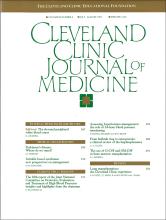Index by author
Vidt, Donald G.
- You have accessFrom bathtub ring to osteoporosis: a clinical review of the bisphosphonatesAngelo A. Licata, MD, PhDCleveland Clinic Journal of Medicine July 1993, 60 (4) 284-290;
BACKGROUND Etidronate and pamidronate are bisphosphonates, a class of chemical compounds originally used to soften hard water and prevent soap scum. Etidronate was serendipitously found to abate calcification in a child with myositis ossificans progressiva.
OBJECTIVE Review the basic pharmacology of these compounds, as well as clinical uses of the approved and nonapproved forms.
DISCUSSION Etidronate is approved for the treatment of hypercalcemia, Paget’s disease of bone, and ectopic calcification, and has been used to treat hyperparathyroidism and nephrolithiasis with limited success. Recently it has been used to treat osteoporosis. Pamidronate is approved to treat hypercalcemia. These two drugs are the only bisphosphonates available in the United States.
CONCLUSIONS Clinical trials with etidronate have aroused widespread interest in the application of bisphosphonates to treat osteoporosis. Many trials are underway to evaluate these new drugs. More information will be available within the next 5 years.
- You have accessThe fifth report of the Joint National Committee on Detection, Evaluation, and Treatment of High Blood Pressure: insights and highlights from the chairmanAlan Bakst, PharmD and Ray W. Gifford, MDCleveland Clinic Journal of Medicine July 1993, 60 (4) 273-277;
Highlights include the new classification schema and recommendations on the use of labetalol.
- You have accessAssessing hypertension management: the role of 24-hour blood pressure monitoringBeatriz Esayag-Tendler, MD and William B. White, MDCleveland Clinic Journal of Medicine July 1993, 60 (4) 278-283;
BACKGROUND The first fully automatic portable invasive blood pressure recorder was developed 30 years ago. Today, portable noninvasive ambulatory blood pressure devices are capable of measuring blood pressure intermittently for periods of 24 to 48 hours.
OBJECTIVE To discuss the utility of automatic ambulatory blood pressure recording in assessing antihypertensive therapy.
SUMMARY Ambulatory blood pressure monitoring is helpful in assessing the pharmacodynamics and the clinical efficacy of an-tihypertensive drugs. It is superior to office blood pressure measurement in predicting hypertensive end-organ disease. In clinical trials, ambulatory blood pressure monitoring permits a more varied population to enter a study, the number of subjects required is often reduced, and a placebo control group may be unnecessary.
CONCLUSIONS The various methods of analyzing ambulatory blood pressure data should be used in a complementary fashion to evaluate antihypertensive drug therapy. We believe that this technique will soon become much more commonly used for hypertension management.
- You have accessThe use of G-CSF and GM-CSF in bone marrow transplantationBrian J. Bolwell, MDCleveland Clinic Journal of Medicine July 1993, 60 (4) 291-302;
Using hematopoietic growth factors appears to have made bone marrow transplantation safer. Treatment-related morbidity and mortality have decreased, and patients are discharged from the hospital sooner.



